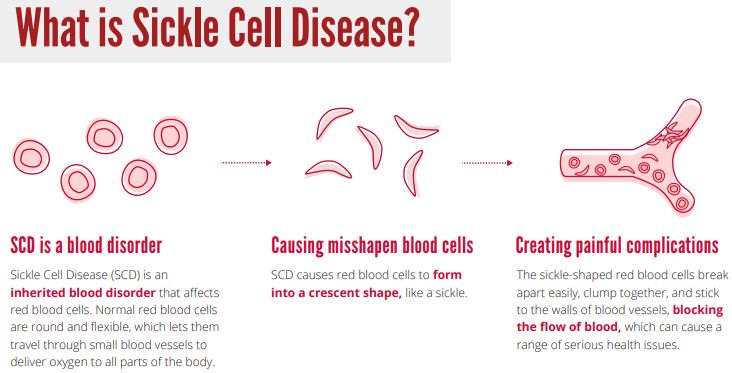Social Justice
World Sickle Cell Day 2020
- 20 Jun 2020
- 5 min read
Why in News
Recently, World Sickle Cell Day 2020 was observed in India to increase awareness about the Sickle Cell Disease (SCD) at the national level.
- The day is recognised by the United Nations and celebrated every year on 19th June.
- The United Nations General Assembly adopted a resolution recognising sickle cell disease as a public health problem on 22th December, 2008.
Key Points
- Sickle Cell Disease
-
- It is an inherited blood disease which is most common among people of African, Arabian and Indian origin.
- It is a group of disorders that affects hemoglobin, the molecule in red blood cells that delivers oxygen to cells throughout the body.
- People with this disease have atypical hemoglobin molecules called hemoglobin S, which can distort red blood cells into a sickle, or crescent shape. This blocks blood flow and oxygen from reaching all parts of the body.
- Symptoms: It can cause severe pain, referred to as sickle cell crises. Infections and fatigue are other symptoms.
- People with sickle cell disorders are also at a risk of complications such as stroke, acute chest syndrome, blindness, bone damage, etc.
- Over time, people with sickle cell disorders can experience damage to organs including the liver, kidney, lungs, heart and spleen. Death can also result from complications of the disorder.
- Treatment: Medication, blood transfusions and rarely a bone-marrow transplant.
- Related Data:
- According to Global Burden of Disease (GBD)—a global research programme that estimates mortality and burden from major diseases across the globe— the prevalence and incidence of sickle cell disease in India in 2017 and 2018 was 1,104,634 and 195,166, respectively.
- The disease in India occurs predominantly in eastern Gujarat, Maharashtra, Madhya Pradesh, Chhattisgarh, western Odisha and in pockets of the Nilgiri Hills in north Tamil Nadu and Kerala.
- The disease is prevalent among tribal communities (including children).
- Challenges:
- Social Stigma: It reduces the effectiveness of screening programmes as people don’t want to go to health authorities.
- Prevalence among Tribal Population: Access to care for SCD in the tribal regions of India is limited.
- School Drop Out: Children with sickle cell disease often have to drop out from school.
- Policy Issue: The delayed implementation of the 2018 draft policy on haemoglobinopathies.
- The policy aims to provide evidence-based treatment for patients and reduce the number of new-born children with sickle cell disease through initiatives such as the Sickle Cell Anaemia Control Program, screening and prenatal diagnosis.
- Initiatives by India:
- Initiative by the Ministry of Tribal Affairs: In order to collect real time data and provide relevant information related to Sickle Cell, the government has launched a new portal which will act as a catalyst in creating awareness.
- The portal will have real time data through a dashboard along with registration facility, information about the disease and various government initiatives undertaken.
- The Ministry has also initiated an ‘Action Research’ project under which Yoga dependent lifestyle is promoted to reduce the complications in the patient suffering from this disease.
- Expanded Screening: Certain states, such as Chhattisgarh and Gujarat, have expanded their screening programmes from hospital to school-based screenings. Extrapolating such screening efforts and implementation strategies to other states will help map the prevalence of the disease.
- Initiative by the Ministry of Tribal Affairs: In order to collect real time data and provide relevant information related to Sickle Cell, the government has launched a new portal which will act as a catalyst in creating awareness.
Way Forward
- SCD is a health burden which not only impacts the individual’s life cycle but also impacts the economy as well.
- There is a need to take efforts so that the next generation is free from the disease.
- The industry like FICCI and other stakeholders have to come forward to improve the overall system of managing the Sickle Cell program of the government.





